Presentation
Student Team Members
| Name | Study Program | Study Year |
| TSUI Suet Ying, Jessica | Biomedical Engineering | 4 |
| ANTHONY, Valensia Nadya | Biomedical Engineering | 4 |
| LEUNG, Shu Lok, Joyce | Biomedical Engineering | 4 |
| WU Omar Kwan Hon | Biomedical Engineering | 4 |
A Non-invasive PPG-based Blood Glucose Measurement using
an Optical Sensor and Optimized Machine Learning Algorithm
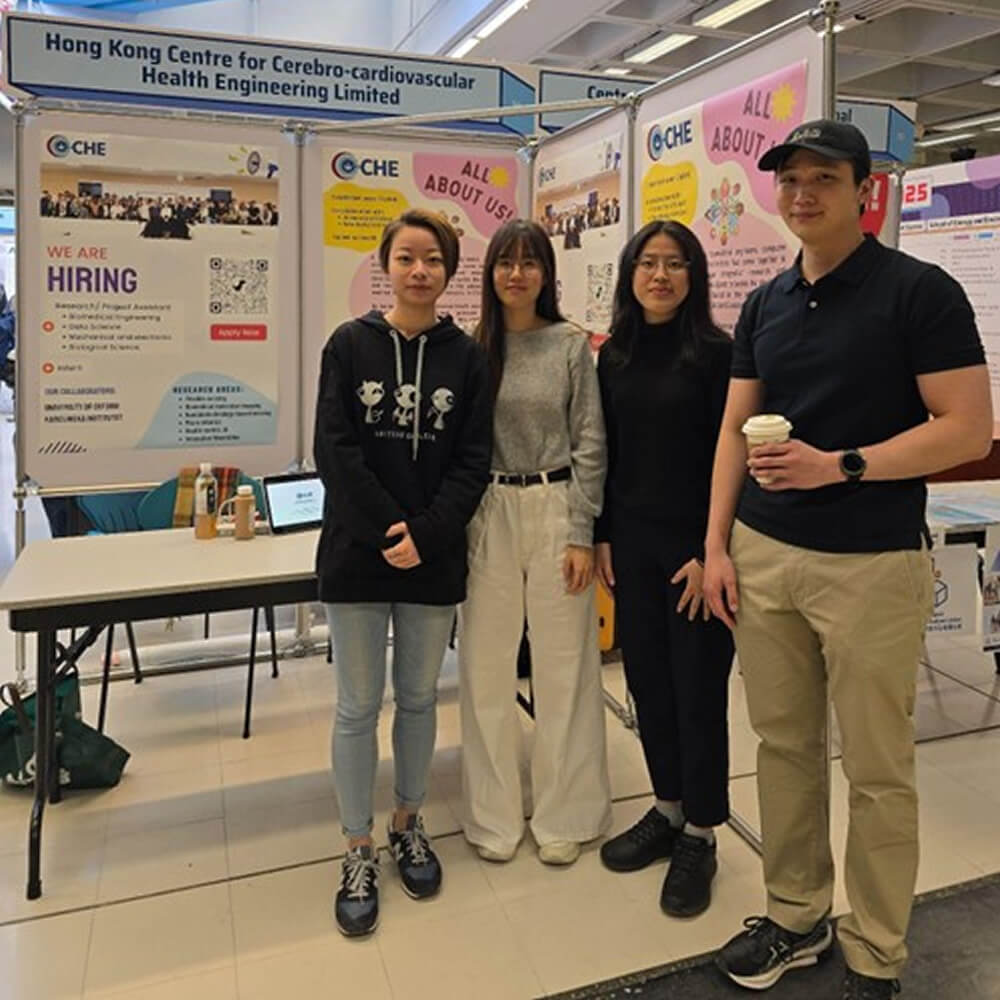
Presentation
Student Team Members
| Name | Study Program | Study Year |
| Li Hiu Laam | Business Computing and Data Analytics | 2 |
| Chow Man Sze | Computer Science | 2 |
| Wu Man Ip | Business Computing and Data Analytics | 2 |
| Cheuk Mei Wan | Business Computing and Data Analytics | 2 |
| Chow Pak Him | Business Computing and Data Analytics | 3 |
| Ng Cheuk Wai | Business Computing and Data Analytics | 2 |
Smart Sustainable Wearables:
Enhancing Health with Smart Technology
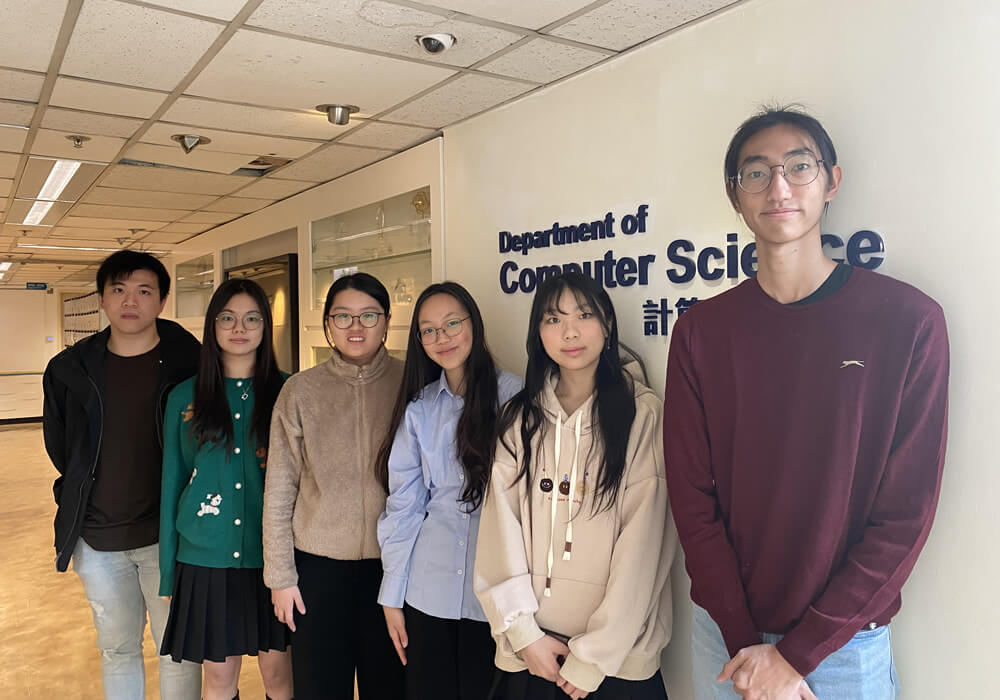
Presentation
Student Team Members
| Name | Study Program | Study Year |
| Sruthi SARAVANAN | Data Science | 2 |
| Areeba SYED | Business Administration | 2 |
| Rassul JAKUPOV | Data Science | 2 |
| Yernur KUANDYKOV | Data Science | 2 |
| Anukaran SUBEDI | Data Science | 1 |
CareNest: AI-Powered Preventive Maintenance System
for an Affordable Baby Incubator in Remote Area
Besides redesigning the baby incubator to ensure that it is safe, functional, portable, energy-efficient and low-cost, data is collected and used for machine learning for fault detection. This enables predictive maintenance and prevents system failures, crucial for hard-to-reach areas where access to immediate technical support is constrained.

Presentation
Student Team Members
| Name | Study Program | Study Year |
| Ankhbayar Enkhtaivan | Computer Engineering | 3 |
| Yum Ho Kan | Computer Engineering | 3 |
| Lei Hei Tung | Computer Engineering | 3 |
| Siu Wai Chuen | Energy and Environmental Engineering | 2 |
Rodentsense: Advanced Rodent Tracker
Rodentsense is an innovative solution that combines robotics and AI to enhance urban hygiene, public health, and quality of life. The system uses fixed or robot-mounted thermal cameras, depending on the environment, to monitor rodent activity in real time and capture hotspot data. AI analyzes movement patterns, activity hotspots, and potential nesting locations to provide precise insights. In outdoor environments, fixed thermal cameras track rodent activity across public spaces, while in indoor spaces, robots move the thermal cameras to explore hard-to-reach areas within buildings, offices, and malls. This integration of AI and robotics improves the efficiency of rodent control, enabling targeted interventions in both environments. By offering real-time data and actionable insights, Rodentsense contributes to a healthier, more sustainable urban environment, promoting better public health and overall well-being.
Presentation
Student Team Members
| Name | Study Program | Study Year |
| ZHANG YIFAN | Artificial Intelligence And Information Engineering | 2 |
| TURALY Yerlan | Aviation Engineering | 3 |
| Ravindu Kannangara | Physics & Artificial Intelligence and Data Analytics | 2 |
| GUAN ZIBO | Civil Engineering (Smart Mobility) & Artificial Intelligence and Data Analytics | 2 |
| LUO TIANYOU | Artificial Intelligence And Information Engineering | 2 |
| LIU MINGZHEN | Land Surveying And Geo-Informatics & Artificial Intelligence and Data Analytics | 3 |
Doctor Diaper: Intelligent Safeguard for elderly well-being
As the global elderly population continues to rise, concerns about their health are becoming increasingly urgent. Many health issues develop silently, often going unnoticed until they become severe. A promising solution to this challenge is the "Doctor Diaper," a smart diaper that utilises advanced materials and AI technology to detect changes in urine and stool. This innovative product provides timely alerts to caregivers and family members, ensuring immediate attention to potential health concerns. By analysing health data, "Doctor Diaper" not only enhances the quality of life for elderly people but also promotes proactive health management and early detection of risks. In cities like Hong Kong, where an aging population presents significant challenges, our product streamlines the delivery of elderly care. Ultimately, "Doctor Diaper" aims to improve patient outcomes and foster a supportive environment for elderly people, ensuring their comfort and well-being in daily life.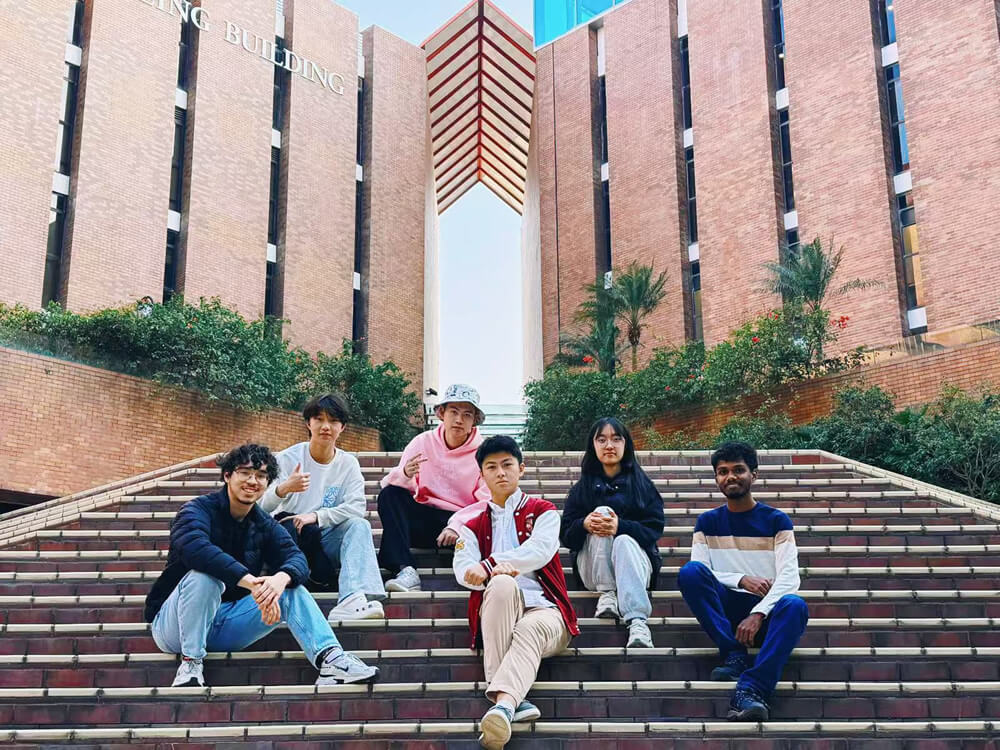
Presentation
Student Team Members
| Name | Study Program | Study Year |
| Likithpranai Mukkamala | Computer Engineering | 2 |
| Antariksh Verma | School of Engineering | 1 |
| Saanvi Shukla | Computer Science and Engineering | 2 |
| Kashish Keswani | Quantitative Finance | 2 |
| Kushaj Dwivedi | Computer Engineering, Dual Degree Program in Technology and Management |
2 |
| Li Ho | Technology and Management | 2 |
CalmSense
Behind the vibrant streets of Hong Kong lies a city where stress is a constant companion—87% of us feel its weight, well above the global average of 80%. To make matters worse, finding affordable mental health support is a challenge, pushing therapy costs sky-high.That's where CalmSense steps in - a wearable AI companion powered by cutting-edge BCI (brain-computer interface) tech. CalmSense monitors your mood and stress levels in real-time, keeping a watchful eye and notifying you when things start to shift. Paired with a handy smartphone app, it gives you detailed insights and extra support right when you need it most.
By keeping tabs on your mental state around the clock, CalmSense helps catch potential issues early on, before they become more serious. Our goal is simple: to reduce stress levels among Hong Kong’s young professionals and students, paving the way for a healthier, more balanced future.

Presentation
Student Team Members
| Name | Study Program | Study Year |
| Kongsawangchai Areeya | Chemistry and Computer Science | 3 |
| Phurtivilai Patt | Computer Science | 3 |
| Chloe Jingjing Gao | Computer Science | 2 |
| Xie Jintao | Data Science and Engineering | 2 |
| Chen Liangyi | Computer Science | 2 |
| Li Haohua | Data Science and Engineering | 2 |
InnoGrow: Smart Weeding Solutions
for a Sustainable Future
Housed in a modular box, the device is versatile and compatible with handheld tools and tractors, making it adaptable to various agricultural landscapes and farm sizes. Its compact and cost-effective design offers a viable alternative to traditional, expensive weed control methods, promoting a transition toward non-toxic, sustainable agricultural practices.
By addressing these pressing agricultural challenges, InnoGrow aspires to enhance public health and food productivity while promoting environmentally responsible farming for a more sustainable future.

Presentation
Student Team Members
| Name | Study Program | Study Year |
| Sanskar SHRESTHA | Computer Science | 4 |
| KADESSOVA Ayazhan | Computer Science | 3 |
| UCHE Destiny Nnanna | Computer Science | 3 |
| Mohammad Riasad HUQ | Computer Science | 2 |
| ONG Jun Kye Eric | Computer Science | 3 |
InfoBite: Enhancing Food Awareness and
Nutritional Monitoring for Vulnerable Individuals
Thus, we are developing an AI-powered solution that leverages technology to empower vulnerable individuals by providing them with comprehensive information about their food intake and alerting them to potential risks based on their specific vulnerabilities. This solution aligns with the theme of "AI-empowered Solutions for Climate Change Challenges" and contributes to the United Nations' Sustainable Development Goals.


Presentation
Student Team Members
| Name | Study Program | Study Year |
| LIU Xianlong Lambert | Computer Science | 2 |
| CHAN Lap Yan Lennon | Artificial Intelligence Science and Technology | 1 |
| Thapakorn PIPATPAJONG | Computational Data Science | 2 |
| WEI Chi Kong Thomas | Earth and Environmental Sciences | 2 |
Prediction of Natural Catastrophe using Artificial Intelligence
Natural catastrophes can cause loss of life and damage property. With the increasing severity of climate change, the frequency of disasters has significantly risen.Consequently, having accurate predictions of these disasters would be immensely beneficial for addressing the problems of lack of preparation for people living there when they are facing the catastrophe, especially in less developed countries.
In our project, we predict the occurrence of a weather-related catastrophe using weather data as input and catastrophe data as labels, including heat waves, and typhoons. After feeding the data to our model, the project can forecast some catastrophes in the near future based on the weather data and able to inform people to be prepared in advance.



Presentation
Student Team Members
| Name | Study Program | Study Year |
| GUO Aobo | Electrical Engineering | 2 |
| CHU Weiqi | Civil Engineering | 3 |
| Sanseong KWEON | Nuclear & Risk Engineering | 2 |
| Jason ALEXANDER | Civil Engineering | 3 |
| QUE Yue | Data Science | 3 |
AI-Assisted Smart Space Cooling Approach with Ultra-High Cooling Power
The increasing worldwide demand for cooling and electricity exacerbates the problem of global warming. Recent studies indicate that the increasing global adoption of air conditioners will triple the energy demand for space cooling without any action to address energy efficiency by 2050. Therefore, developing cooling technologies that operate with lower energy consumption is the research we investigate. Inspired by how camels adapt in the desert, we design a camel-fur-inspired sorbent that can periodically absorb the moisture from the air at night and release its stored water during the daytime for building cooling. The novel sorbent would circulate in response to the environment and exhibit outstanding cooling performance, which is almost 4 times the classical radiative-cooling approach. Concurrently, we propose an Artificial Intelligence (AI) integrated with ultra-high cooling power sorbent to achieve smart cooling in buildings. Highly effective cooling control can be managed by analysing user behaviour through AI.


Presentation
Student Team Members
| Name | Study Program | Study Year |
| PAL Ileana | Mechanical Engineering | 3 |
| DUAN Mingjie Josie | Land Surveying and Geo-informatics | 3 |
| WANG Zian Peter | Electronic and Information Engineering | 3 |
| GAMAGE Sashenka | Electronic and Information Engineering | 2 |
| WANG Youkang Albert | Computer Science | 2 |
| ZHANG Tianyi Tonax | Computer Science | 3 |
EcoFlight: Enhancing Aircraft Ground Operations for Reduced Carbon Emissions
We will develop an innovative AI solution to reduce carbon emissions from aircraft ground operations. Aviation accounts for a large share of transport sector pollution, and engines emit substantial greenhouse gases during taxi, takeoff, and landing. Using sensors to capture real-time engine usage and flight schedules, our system trains a predictive model on how operational factors like pushback timing, taxi routes, and takeoff weight affect emissions output. This model then identifies strategic recommendations tailored for each airport and airline to minimize pollution through optimized engine start windows, efficient runway sequencing, and congestion-alleviating gate assignments that shorten taxi distances. Our automated solution assigns boarding gates and designs taxi routes leveraging its emission predictions. By facilitating intelligent, emissions-conscious ground movement planning through our data-driven approach, we aim to help the aviation industry significantly lower its environmental impact through airport resource utilization.


Presentation
Student Team Members
| Name | Study Program | Study Year |
| CHEN Wai Yan Grace | School of Engineering, Artificial Intelligent | 1 |
| CHI Ting Hsuan | Computer Science and Electronic Engineering | 3 |
| TAM Siu Ho | Electronic Engineering, minor in Information Technology | 2 |
| TANG Justin Kit Hang | World Bachelor in Business | 2 |
| TANG Lok Hang | School of Engineering | 1 |
| WONG Wing Him | Electronic Engineering | 3 |
AI-based Photogrammetry for 3D Reconstruction and
Monitoring of Underwater Coral Growth



Presentation
Student Team Members
| Name | Study Program | Study Year |
| Jose Alberto Espino PITTI | Computer Engineering | 3 |
| En Yu YAP | Chemistry | 3 |
| Patt PHURTIVILAI | Computer Science, minor in statistics | 2 |
| Abraham CHANDAFA | Computer Science, minor in Electrical and Electronics Engineering | 2 |
| Cheuk Lam TSANG | Chemistry | 2 |
| Hanyi XIONG | Applied AI | 1 |
FarmGPT: Securing Food Production in the face of
Climate Change with Approachable AI
To address these issues, we propose FarmGPT, an AI-based solution for farmers. Our project involves fine-tuning a chatbot with two types of information. Firstly, we utilize farming-related data, such as AFCD reports, to ensure the model provides accurate information. Secondly, we input farm-specific information obtained through sensors and cameras to generate tailored recommendations that minimize the impact of these challenges.
FarmGPT has a twofold impact.
Firstly, it empowers farmers by providing dynamic AI analysis of their farmland, bridging the technology gap through conversational and digestible information.
Secondly, it enables precision agriculture, allowing farmers to scale their operations while adapting to specific land needs. This approach reduces the reliance on destructive practices like tilling and nitrogen fertilizers, which contribute to climate change. By embracing precision agriculture, farmers can better adapt to the changing environment caused by climate change and mitigate its effects.



Presentation
Student Team Members
| Name | Study Program | Study Year |
| Liu Yuen Ching | BSc Business Computing and Data Analytics | 2 |
| Chu Ho Chun | BSc Business Computing and Data Analytics | 2 |
| Wong Sze Chun | BSc Business Computing and Data Analytics | 2 |
| Wong Chun Shing | BSc Business Computing and Data Analytics | 2 |
| Yim Yuk Sing | BSc Business Computing and Data Analytics | 2 |
HawkEye
An effective way to prevent the further spread of COVID-19 is through citizens’ efforts. Related government departments have sent personnel to carry out different measures. However, the cost of human resources is relatively high, and the efficiency and effectiveness may not be satisfactory. Considering this, we have used the techniques learned in electronic engineering and computer science to design an automated supervision, education and promotion system. It is used to prevent an outbreak and get society out of the haze in a short time by promptly creating a more rigorous atmosphere for pandemic prevention.

Presentation
Student Team Members
| Name | Study Program | Study Year |
| Chan San Yu | Energy and Environmental Engineering (EEEN) | 3 |
| Wong Chi Ka | Bachelor of Medicine and Bachelor of Surgery (MBChB) | 3 |
| Cheung Justin | Electronic Engineering (ELEG) | 3 |
| Saung Hnin Phyu | Energy and Environmental Engineering (EEEN) | 3 |
Drink2Eat
Food is fundamental to not only our survival but also our health. Humanity has made leaps and bounds in improving the quantity, quality, longevity and accessibility of food through food engineering and standardized global shipping distribution networks.However, these improvements have also generated a lot of waste from the packaging of food and drinks. Furthermore, restrictions of Hong Kong’s restaurant dine-in times have massively popularized the concept of ordering takeout. This has exasperated the food packaging waste issue by 15%. This food packaging issue contributes to Hong Kong's landfills that would fill up in less than 12 years.
Drink2Eat would like to combat this issue of food packaging waste by reusing common carton boxes typically used for drinks to make lunch boxes so that restaurants can decrease their reliance on disposable lunchboxes for takeout orders.
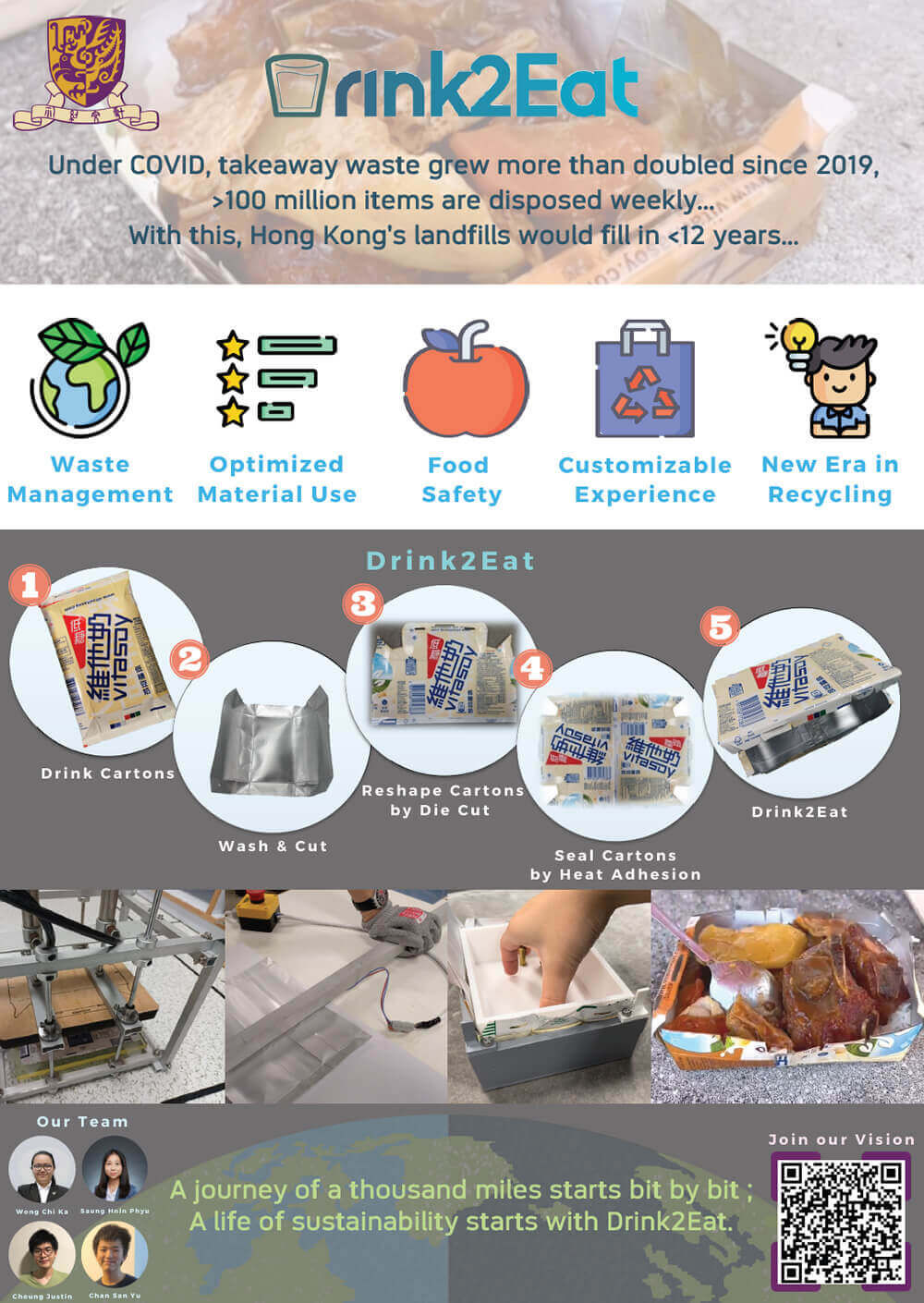

Presentation
Student Team Members
| Name | Study Program | Study Year |
| Pun Jenit | Engineering in Civil Engineering | 2 |
| Wei Yuanting | Engineering in Civil Engineering (structural engineering stream) | 3 |
| TENG Zhaohan | Engineering in Architectural Engineering | 2 |
| BAO Yiran | Engineering in Civil Engineering | 2 |
| LI Zuer | Engineering in Civil Engineering | 2 |
From RFM to SGS Concrete
Due to the aggravating situation of the pandemic, the use of surgical masks has increased. It has led to many problems due to the over disposal of face masks. With the current pandemic trend, a large number of masks will still be in use for epidemic prevention purposes for a long time. On the other hand, the demand for green building materials is rising. Our solution will aid in solving both issues by incorporating the polypropylene fibers compromised in surgical masks into forming sustainable green structural concrete. Before adding it to the concrete mix, they will be appropriately collected, sterilized, and extracted. InNews_20210911_037.jpg addition to being used to form green concrete, it will also reduce the potential landfill space uptake by many disposed of masks after the pandemic and hence provide a head start to future waste management incentives programs.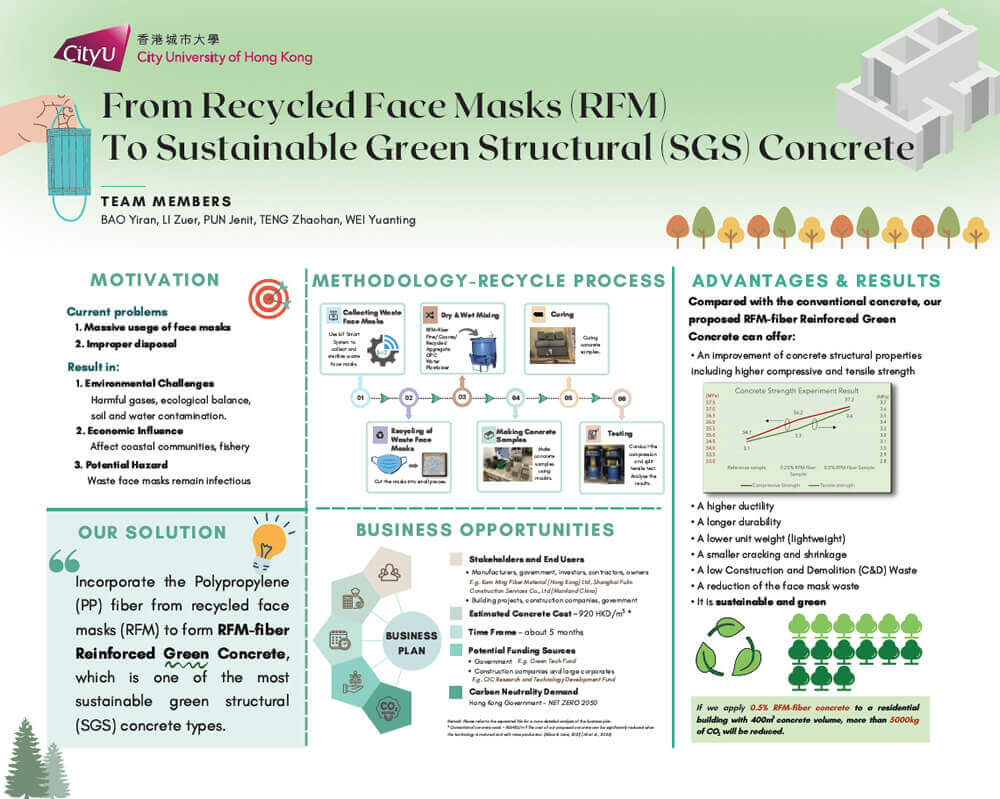

Presentation
Student Team Members
| Name | Study Program | Study Year |
| ZHANG Xinzhi | Investment Science and Finance Analytics | 3 |
| FENG Lin | Biomedical Engineering | 2 |
| SU Chung Hang | Civil Engineering | 3 |
| ZHU Zixuan | Electrical Engineering | 2 |
| Alisher MYRGYYASSOV | Electronic and Information Engineering | 2 |
| CAI Yangnuo | Internet and Multimedia Technology | 2 |
PolyCare ------ Multi-functional Medical Assistant Robotic System
PolyCare, an integrated robotic system for medical care, is aiming at addressing the current and potential shortage of medical resources, especially for the shortage of nursing staff. PolyCare can provide basic medical services: identifying and collecting the physical conditions of patients and providing far-flung/inaccessible medical consultation if professional doctors are needed to be involved.While working in the hospital ward or mass quarantine area, PolyCare can navigate itself to designated rooms and distribute medicines for patients. Besides, the robot can issue warnings to people without the mask. PolyCare will also create a personal medical profile for each patient, storing the body condition data and diagnosis records. In order to realize the above functions, PolyCare has the following equipment :
- Fundamental medical devices, including thermometer and blood pressure monitor
- Medicine delivery box
- High-resolution camera and screen
- Navigation devices and data processor
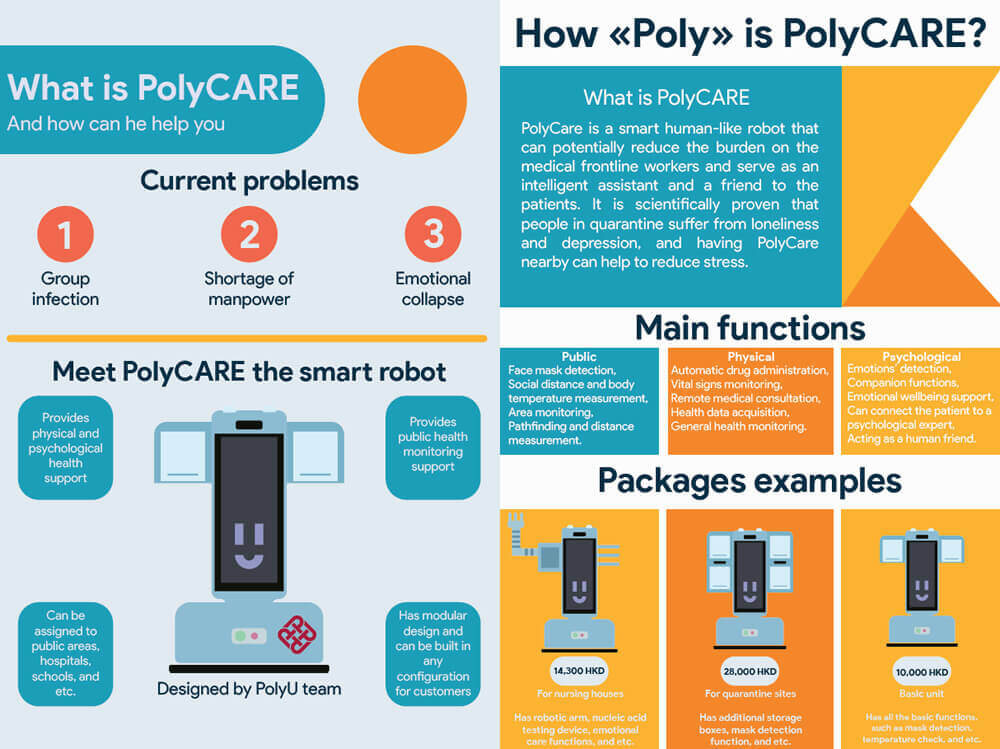

Presentation
Student Team Members
| Name | Study Program | Study Year |
| CHANG, Sin Tong | BEng in Civil Engineering | 2 |
| REXMARIN, Nicko | BEng in Bioengineering | 3 |
| SEN, Yigit | BEng in Computer Science & BBA (Undeclared) | 2 |
| WONG, Hiu Ching | BEng in Bioengineering & BBA in Global Business Management | 3 |
| WONG, King Wang | BSc Economics and Finance & Computer Science | 2 |
| YANG, Tiffany | BSc in Integrative Systems & Design & BBA (Undeclared) | 2 |
Guardiosk
Guard with ease.
Our team believes that in a dire crisis, human ingenuity is essential in easing the task of multiple stakeholders. With Guardiosk, we trust that we can aid everyone in weathering these hard times.


Presentation
Student Team Members
| Name | Study Program | Study Year |
| Lai Chun Kit | BEng (BME) | 2 |
| Rachel Natalie | BEng (BME) | 2 |
| Nafisa Humayra | BEng (BME) | 2 |
| Zhao Yazhou | BEng (EngSc) | 2 |
PERfECT Viral Sewage Monitoring System
Epidemics cause historical global panic in public health, urgently requiring sensitive and cost-effective biosensors that screen diseases efficiently, over time-consuming testing kits that are mailed to research labs. We have developed the world’s smallest platform, PERfECT (“personalized electronic reader for electrochemical transistors”). PERfECT has been modified to make a wireless, compact Virus Detector that can detect viruses at the earliest possible time. PERfECT acts as a supplement to LeaveHomeSafe, which notifies viral exposure a few days too late as viruses keep spreading before the notification is received. Instead, PERfECT could be placed in MTRs, restaurants, personal belongings, etc., alerting the public to viral exposure in seconds. This would greatly reduce viral transmission and aid in curbing the epidemic. PERfECT is the epitome of engineering in health innovation, fighting the epidemic through fast virus detection, enabling speedy restoration of normal life, and offering fast response technologies for future crises.
